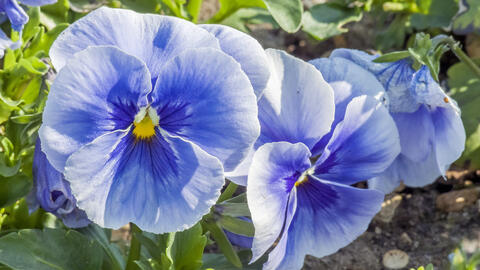5 Plants You Can Sow in July
In addition to biennials, some types of vegetables and herbs are also suitable for sowing in July. We introduce you to five recommended plants.

Pansies (Viola x wittrockiana hybrids) can be sown in July. The classics love a slightly damp, humus-rich soil
July is the perfect month to sow biennial flowering plants. In favorable climate conditions, they soon enchant us with their wonderful colors. In the vegetable garden the first beds have already been harvested. Now it’s time to sow the first fall and winter vegetables.
- Pansy
- Lamb’s lettuce
- Parsley
- Bellis
- Radish
Pansies (Viola x wittrockiana hybrids) are one of the classics in decorative gardens and are usually cultivated biennially in temperate climates. Depending on the variety, the viola plants adorn themselves with large, often multi-colored flowers that shine in colors ranging from white to blue and purple. If you plant the short-lived shrubs in July, they can develop into powerful - often already flowering - specimens by the fall. The plants can be individually separated off and planted in the desired place in the garden in September. They are happiest in a sunny to semi-shady spot. The soil should be very loose, nutrient-rich and contain humus. If you put the plants in a flower bed, observe a distance of about 7.87 inches from the neighboring plants. Water with non-calciferous rain water and always keep the substrate fresh to moist, but not wet.

If you want to enjoy the first harvest-fresh in September, you can sow the vitamin-rich vegetable from mid-July. Delicate leaf varieties such as ‘Gala’ or ‘Favor’ are recommended for the fall harvest. Frost-hardy varieties such as ‘Verte de Cambrai’, ‘Vit’, and ‘Dutch broad-leaf’ are ideal for overwintering outdoors. First, loosen the soil in a sunny , remove any weeds, and lightly water. You can then sow the seeds - either by broadcasting them or sowing in rows. A distance of around 3.94 inches and a groove depth of 0.2 to 0.4 inches is recommended when sowing in rows. Cover the seeds with soil, press this down with a board, and keep the substrate evenly moist. The seeds germinate after about three weeks - the chances of germination are even greater with a film cover. The first heads can be harvested after eight to ten weeks.

Herb lovers can sow parsley in July. The popular cooking herb grows particularly well in mixed cultivation with tomatoes - both in a pot and in a bed. Take care when choosing the location: parsley should only be grown in the same location every four to five years. It’s best to sow the herb in a greenhouse from mid-July for a winter harvest. However, you should ensure there is sufficient ventilation in the greenhouse on hot, sunny days. In general, row distances of 7.87 to 11.81 inches and a sowing depth between 0.4 and 0.79 inches are recommended. Water the soil evenly during the germination phase and always keep it free from weeds. The seeds should germinate after three to four weeks, you can harvest the first parsley leaves after about eight weeks.

Bellis, also called daisies, ensure beautiful dashes of color in the spring and summer with their globe flowers. If you want to enjoy the biennial flowering beauties, you should sow them directly in the flower bed or plant container in July. They thrive best in a sunny to semi-shady place in the garden. It is advisable to loosen the soil well and improve it with compost before sowing. It is also important to sow the seeds flat and never allow them to dry out. As ever, sensitivity is also required here, as bellis does not tolerate waterlogging at all. If these conditions are met, the seeds should develop into a little plant after one to two weeks. The young plants should be covered with fir brushwood as a precaution before the first frosts.

Sowing radish in July is also advisable for a late harvest and winter storage. A classic fall radish, for example, is ‘Münchner Bier’, and a winter radish is ‘Brauner Fridolin’. Ideally, the soil for these plants with medium nitrate and nutrient requirements should be heavily loosened and humus-rich, but not freshly fertilized. Make sure that no other cruciferous plants have grown in the bed in the past three years. Sow the seeds 0.79 to 1.18 inches deep with a distance of about 11.81 inches between rows. The distance in rows should be 3.94 to 5.91 inches. It takes about eight to ten weeks between sowing and harvesting, depending on the variety. For winter radishes you will generally have to wait 13 to 15 weeks. Fall and winter radishes are generally well-suited to storage and keep for several months at temperatures around freezing.



